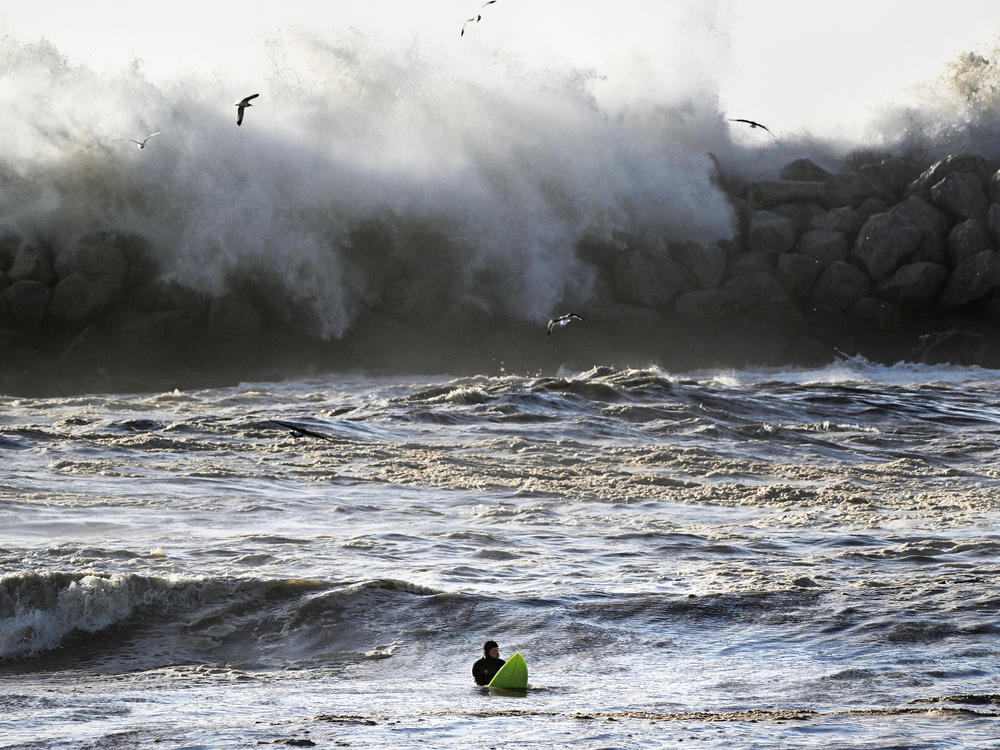Section Branding
Header Content
Surf's up! Wave heights increase on California's coast as climate warms
Primary Content
Earlier this year, California was pummeled by what local surfers described as the best swell in decades: massive waves that damaged piers, crumbled sea cliffs and flooded coastlines. A new study finds that wave heights are getting bigger along the California coast as global temperatures have warmed.
The study, published Tuesday in the Journal of Geophysical Research: Oceans, looked at nearly a century's worth of data and found that the average height of winter waves has grown by about a foot since 1969. The number of storm events that produced waves greater than 13 feet in height has also increased, the study found.
In that same time, the burning of fossil fuels has contributed to an increase in average global temperatures by more than 1 degree Fahrenheit.
"This is just another indication that overall average wave heights have increased significantly since 1970 — since the advent of the upward trend in global warming," said Peter Bromirski, researcher emeritus at the Scripps Institution of Oceanography and the study's author.
Global climate-warming carbon dioxide has increased by about 90% since 1970, federal data shows.
While bigger waves may be a boon to surfers, they can also be damaging to California's already climate-vulnerable coast.
Warmer ocean temperatures and inflows of fresh water from the world's melting ice caps have caused sea levels to rise roughly 8 inches along California's 1,200 mile coastline in the last century, according to the California Coastal Commission. Without rapid cuts in greenhouse gas emissions, they could rise by feet in the coming decades.
By the turn of this century, federal estimates warn that nearly three-quarters of California's picturesque beaches may be completely eroded by rising seas. A report by California's nonpartisan Legislative Analyst's Office found that between $8 billion and $10 billion worth of existing property is likely to be underwater within the next few decades, with an additional $6 billion to $10 billion worth of property at risk during high tides.
"Higher waves with higher sea levels allows more wave energy to reach vulnerable sea cliffs and also enhances coastal flooding as well as damage to coastal infrastructure," said Bromirski.
The new study adds to a growing body of research that suggests storm activity in the Northern Pacific Ocean — the main source of California's winter swells — has increased as human activities have caused the world's temperature to warm. A 2019 study by researchers at the University of California, Santa Cruz found that the energy in ocean waves has increased over most of the last century because of climate change.
Another study, published by a team of international researchers in 2021, found that climate change is causing wave power — the energy transferred from winds to waves — to increase globally, particularly in the Southern Hemisphere.
"The areas where we see the most warming in the global oceans is where we tend to see the most significant increases in wave power," said Tom Mortlock, one of the study's authors and an Australian-based senior analyst at the insurer Aon. "The reason for this is that as oceans warm, they intensify the circulation of winds over the ocean, and stronger winds drive higher waves."
Bromirski used seismic records dating back to 1931 to get a sense of how much wave heights had changed off California's coast during the winter months. When waves ricochet off the coast, they send energy back toward the sea. When that energy hits incoming waves, it pushes energy downward, creating a seismic signal that can be detected.
Bromirski, who got a Ph.D. in seismology in 1993, knew that those wave-to-wave interactions caused seismic signals that could be detected underwater and on land, "but nobody had tried to invert the seismic signals for wave height," he said.
Interpreting the seismic data was crucial to understanding how wave heights had changed over most of the last century, Bromirski said. Buoys that measure wave height along the West Coast had been collecting data only since 1980, after the rapid intensification of greenhouse gas emissions had already begun.
By using seismic data, Bromirski could look for patterns in a longer window of time. Two notable periods stood out. From 1939 to 1947 and 1957 to 1965 there were extended periods of "exceptionally low winter wave activity," Bromirski said. "There's been nothing like that since 1970."
Copyright 2023 NPR. To see more, visit https://www.npr.org.

